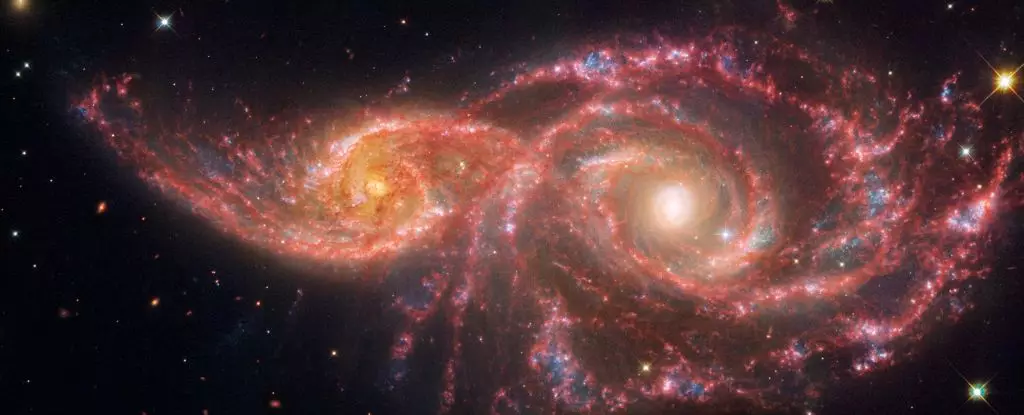In 1886, Friedrich Nietzsche expressed profound contemplation about the nature of existence with the ominous remark: “If you gaze for long into an abyss, the abyss gazes also into you.” This philosophical insight, while deeply introspective, takes on a new layer of meaning when viewed through the lens of contemporary astrophysics. Over a century later, we find ourselves peering into the abyss of space, where the visual splendor of colliding galaxies evokes a striking visual that appears to stare back at us. The merging of NGC 2207 and IC 2163, captured by the powerful lenses of the Hubble Space Telescope and the James Webb Space Telescope (JWST), provides a tangible connection to Nietzsche’s concept: a profound realization of our place within a universe larger and more intricate than we can fathom.
The merging of galaxies is not an instantaneous cataclysm but rather a gradual process resembling an elaborate cosmic dance. NGC 2207 and IC 2163 are not strangers; their paths have crossed before, and they are now engaged in a slow yet dynamic orbital interaction. This lengthy process is a complex interplay of gravitational forces that will eventually culminate in the formation of a single, magnificent galaxy. While currently maintaining distinct spiral structures, the gravitational embrace between them draws forth rampant star formation, significantly different from the more tranquil star birth observed in our own Milky Way. Stars, born from the compression of interstellar gas clouds, light up the cosmic canvas with the complexity of their formation.
As these spiraling galaxies near each other, their mutual gravitational attraction catalyzes an explosion of star creation. With the density of gas clumps increasing under the immense pressure of gravity, new stars emerge, joining the endless cycle of life and death in the cosmos. Astonishingly, both NGC 2207 and IC 2163 are producing dozens of solar masses in new stars each year, showcasing a vibrant contrast to our galaxy, which births far fewer pioneering stars. This period of cosmic activity is a testament to the enchanting chaos that exists in the universe, where destruction and creation occur simultaneously.
The narrative of stellar creation is inevitably entwined with the story of stellar demise. Many new stars, particularly the massive ones, live fast and die young, often ending their lifespans in spectacular supernova explosions. These violent ends are not merely the cessation of celestial bodies but serve to propagate more star formation. When these stars explode, they unleash energy that propagates through space, shocking and compressing nearby gas clouds—a catalyzing force that births yet more stars. This cycle of stellar life and death creates a tapestry of light and energy, visible in the vibrant colors captured by space telescopes.
What emerges from these cosmic interactions is an intricate depiction of a universe in constant flux. Observations made by Hubble reveal luminous areas of star formation in bright, pale blue hues, signaling regions rich with young stars. In contrast, the JWST captures the intricate arrangement of dust across both galaxies, displaying a web of interstellar material acting as the nursery for ongoing star births. These observations deepen our understanding of cosmic mechanics while illustrating the ephemeral beauty of life within the universe. Perhaps Nietzsche’s philosophy can be supplemented with the notion that through our explorations, we glimpse the magnificent complexity of the universe, gaining insight into its galactic machinations and, in turn, our own existence.
In this vast expanse of stars and galaxies, we find ourselves dwarfed by the enormity of cosmic occurrences that unfold over millions of years. The mesmerizing interaction between NGC 2207 and IC 2163 is but a small chapter in the grand cosmic saga; yet, it serves as a profound reminder of our place within the universe. Rather than feeling insignificant, one might embrace the notion that in contemplating these celestial dances, we connect with the essence of existence itself—an ever-evolving narrative steeped in mystery and wonder.


Leave a Reply